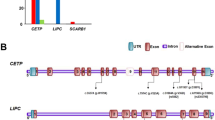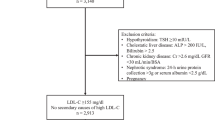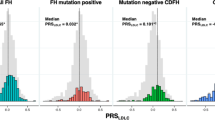Abstract
Background Several known candidate gene variants are useful markers for diagnosing hyperlipoproteinemia. In an attempt to identify other useful variants, we evaluated the association of two common APOA5 single-nucleotide polymorphisms across the range of classic hyperlipoproteinemia phenotypes.
Methods We assessed plasma lipoprotein profiles and APOA5 S19W and −1131T>C genotypes in 678 adults from a single tertiary referral lipid clinic and in 373 normolipidemic controls matched for age and sex, all of European ancestry.
Results We observed significant stepwise relationships between APOA5 minor allele carrier frequencies and plasma triglyceride quartiles. The odds ratios for hyperlipoproteinemia types 2B, 3, 4 and 5 in APOA5 S19W carriers were 3.11 (95% CI 1.63–5.95), 4.76 (2.25–10.1), 2.89 (1.17–7.18) and 6.16 (3.66–10.3), respectively. For APOA5 −1131T>C carriers, the odds ratios for these hyperlipoproteinemia subtypes were 2.23 (95% CI 1.21–4.08), 3.18 (1.55–6.52), 3.95 (1.85–8.45) and 4.24 (2.64–6.81), respectively. The overall odds ratio for the presence of either allele in lipid clinic patients was 2.58 (95% CI 1.89–3.52).
Conclusions A high proportion of patients with four classic hyperlipoproteinemia phenotypes are carriers of either the APOA5 S19W or −1131T>C variant or both. These two variants are robust genetic biomarkers of a range of clinical hyperlipoproteinemia phenotypes linked by hypertriglyceridemia.
Key Points
-
Hyperlipoproteinemia types 2B, 3, 4 and 5 feature elevated plasma triglyceride concentration as part of their definition
-
We found that APOA5 variants S19W and −1131T>C are frequently present in and are strongly associated with hyperlipoproteinemia 2B, 3, 4 and 5 and also with hypertriglyceridemia in lipid clinic patients
-
These two APOA5 variants are robust genetic biomarkers of a range of complex hyperlipoproteinemia phenotypes, which had been considered distinct and disparate but which share hypertriglyceridemia as a defining feature
-
These strong genetic associations might help predict susceptibility to hypertriglyceridemia or identify interindividual differences in response to interventions to lower plasma triglyceride
This is a preview of subscription content, access via your institution
Access options
Subscribe to this journal
Receive 12 print issues and online access
$209.00 per year
only $17.42 per issue
Buy this article
- Purchase on Springer Link
- Instant access to full article PDF
Prices may be subject to local taxes which are calculated during checkout


Similar content being viewed by others
References
Wilson PW and Grundy SM (2003) The metabolic syndrome: a practical guide to origins and treatment: Part II. Circulation 108: 1537–1540
Sarwar N et al. (2007) Triglycerides and the risk of coronary heart disease: 10,158 incident cases among 262,525 participants in 29 Western prospective studies. Circulation 115: 450–458
Durrington P (2003) Dyslipidaemia. Lancet 362: 717–731
Yuan G et al. (2007) Hypertriglyceridemia: its etiology, effects and treatment. CMAJ 176: 1113–1120
MacLean DR et al. (1999) Plasma lipids and lipoprotein reference values, and the prevalence of dyslipoproteinemia in Canadian adults. Canadian Heart Health Surveys Research Group. Can J Cardiol 15: 434–444
Talmud PJ and Humphries SE (2002) Gene:environment interaction in lipid metabolism and effect on coronary heart disease risk. Curr Opin Lipidol 13: 149–154
Kryukov GV et al. (2007) Most rare missense alleles are deleterious in humans: implications for complex disease and association studies. Am J Hum Genet 80: 727–739
Yuan G et al. (2006) Heterozygous familial hypercholesterolemia: an underrecognized cause of early cardiovascular disease. CMAJ 174: 1124–1129
Walden CC and Hegele RA (1994) Apolipoprotein E in hyperlipidemia. Ann Intern Med 120: 1026–1036
Pennacchio LA et al. (2001) An apolipoprotein influencing triglycerides in humans and mice revealed by comparative sequencing. Science 294: 169–173
Calandra S et al. (2006) APOA5 and triglyceride metabolism, lesson from human APOA5 deficiency. Curr Opin Lipidol 17: 122–127
Talmud PJ (2007) Rare APOA5 mutations—clinical consequences, metabolic and functional effects: an ENID review. Atherosclerosis 194: 287–292
Pennacchio LA et al. (2002) Two independent apolipoprotein A5 haplotypes influence human plasma triglyceride levels. Hum Mol Genet 11: 3031–3038
Talmud PJ et al. (2002) Relative contribution of variation within the APOC3/A4/A5 gene cluster in determining plasma triglycerides. Hum Mol Genet 11: 3039–3046
Talmud PJ et al. (2005) Determination of the functionality of common APOA5 polymorphisms. J Biol Chem 280: 28215–28220
Anand SS et al. (2000) Differences in risk factors, atherosclerosis, and cardiovascular disease between ethnic groups in Canada: the Study of Health Assessment and Risk in Ethnic groups (SHARE). Lancet 356: 279–284
Hegele RA et al. (2003) Elevated serum C-reactive protein and free fatty acids among nondiabetic carriers of missense mutations in the gene encoding lamin A/C (LMNA) with partial lipodystrophy. Arterioscler Thromb Vasc Biol 23: 111–116
Wang J et al. (2005) Multiplex ligation-dependent probe amplification of LDLR enhances molecular diagnosis of familial hypercholesterolemia. J Lipid Res 46: 366–372
Wang J et al. (2001) Low density lipoprotein receptor (LDLR) gene mutations in Canadian subjects with familial hypercholesterolemia, but not of French descent. Hum Mutat 18: 359
Eichenbaum-Voline S et al. (2004) Linkage and association between distinct variants of the APOA1/C3/A4/A5 gene cluster and familial combined hyperlipidemia. Arterioscler Thromb Vasc Biol 24: 167–174
Assmann G and Schulte H (1992) Relation of high-density lipoprotein cholesterol and triglycerides to incidence of atherosclerotic coronary artery disease (the PROCAM experience). Prospective Cardiovascular Munster study. Am J Cardiol 70: 733–737
Cullen P et al. (1994) Complex segregation analysis provides evidence for a major gene acting on serum triglyceride levels in 55 British families with familial combined hyperlipidemia. Arterioscler Thromb 14: 1233–1249
Goldstein JL et al. (1973) Hyperlipidemia in coronary heart disease. II. Genetic analysis of lipid levels in 176 families and delineation of a new inherited disorder, combined hyperlipidemia. J Clin Invest 52: 1544–1568
Evans D et al. (2005) Polymorphisms in the apolipoprotein A5 (APOA5) gene and type III hyperlipidemia. Clin Genet 68: 369–372
Whitman SC et al. (1997) Uptake of type III hypertriglyceridemic VLDL by macrophages is enhanced by oxidation, especially after remnant formation. Arterioscler Thromb Vasc Biol 17: 1707–1715
Altschul SF et al. (1990) Basic local alignment search tool. J Mol Biol 215: 403–410
NCBI Map Viewer [http://www.ncbi.nlm.nih.gov/mapview/map_search.cgi?taxid=9606] (accessed 19 July 2008)
Applied Biosystems [http://www.appliedbiosystems.com/support/software/]
SAS Institute Inc [http://www.sas.com/technologies/analytics/statistics/stat/index.html]
Stephens M and Donnelly P (2003) A comparison of bayesian methods for haplotype reconstruction from population genotype data. Am J Hum Genet 73: 1162–1169
Ahituv N et al. (2007) In vivo characterization of human APOA5 haplotypes. Genomics 90: 674–679
Wojciechowski AP et al. (1991) Familial combined hyperlipidaemia linked to the apolipoprotein AI-CII-AIV gene cluster on chromosome 11q23-q24. Nature 349: 161–164
Hopkins PN et al. (1991) Type III dyslipoproteinemia in patients heterozygous for familial hypercholesterolemia and apolipoprotein E2. Evidence for a gene-gene interaction. Arterioscler Thromb 11: 1137–1146
Moennig G et al. (2000) Detection of missense mutations in the genes for lipoprotein lipase and hepatic triglyceride lipase in patients with dyslipidemia undergoing coronary angiography. Atherosclerosis 149: 395–401
Zhang H et al. (1995) Patients with apoE3 deficiency (E2/2, E3/2, and E4/2) who manifest with hyperlipidemia have increased frequency of an Asn 291→Ser mutation in the human LPL gene. Arterioscler Thromb Vasc Biol 15: 1695–1703
Groenewegen WA et al. (1994) Dysbetalipoproteinemia in a kindred with hypobetalipoproteinemia due to mutations in the genes for ApoB (ApoB-70.5) and ApoE (ApoE2). Arterioscler Thromb 14: 1695–1704
Schaefer JR et al. (2004) Hyperlipidemia in patients with apolipoprotein E 2/2 phenotype: apolipoprotein A5 S19W mutation as a cofactor. Clin Chem 50: 2214
Hubacek JA et al. (2005) Hypertriglyceridemia: interaction between APOE and APOAV variants. Clin Chem 51: 1311–1313
Martín-Campos JM et al. (2006) Apolipoprotein A5 S19W may play a role in dysbetalipoproteinemia in patients with the Apo E2/E2 genotype. Clin Chem 52: 1974–1975
Henneman P et al. (2007) Plasma apoAV levels are markedly elevated in severe hypertriglyceridemia and positively correlated with the APOA5 S19W polymorphism. Atherosclerosis 193: 129–134
van der Vleuten GM et al. (2007) Haplotype analyses of the APOA5 gene in patients with familial combined hyperlipidemia. Biochim Biophys Acta 1772: 81–88
Wang J et al. (2007) Resequencing genomic DNA of patients with severe hypertriglyceridemia (MIM 144650). Arterioscler Thromb Vasc Biol 27: 2450–2455
Acknowledgements
R Provost provided outstanding technical assistance. Supported by the Jacob J Wolfe Distinguished Medical Research Chair (RAH), the Edith Schulich Vinet Canada Research Chair (Tier I) in Human Genetics (RAH), a Career Investigator award from the Heart and Stroke Foundation of Ontario (RAH), and operating grants from the Canadian Institutes for Health Research (MOP-13430, MOP-39533, MOP-39833), the Heart and Stroke Foundation of Ontario (grants PRG-5967, NA-6059, T-6018) and the Ontario Research Fund and by Genome Canada through the Ontario Genomics Institute.
Author information
Authors and Affiliations
Corresponding author
Ethics declarations
Competing interests
The authors declare no competing financial interests.
Rights and permissions
About this article
Cite this article
Wang, J., Ban, M., Kennedy, B. et al. APOA5 genetic variants are markers for classic hyperlipoproteinemia phenotypes and hypertriglyceridemia. Nat Rev Cardiol 5, 730–737 (2008). https://doi.org/10.1038/ncpcardio1326
Received:
Accepted:
Published:
Issue Date:
DOI: https://doi.org/10.1038/ncpcardio1326
This article is cited by
-
Association of lipid metabolism-related gene promoter methylation with risk of coronary artery disease
Molecular Biology Reports (2022)
-
Association of BUD13-ZNF259-APOA5-APOA1-SIK3 cluster polymorphism in 11q23.3 and structure of APOA5 with increased plasma triglyceride levels in a Korean population
Scientific Reports (2019)
-
APOA5 Q97X Mutation Identified through homozygosity mapping causes severe hypertriglyceridemia in a Chilean consanguineous family
BMC Medical Genetics (2012)
-
Common functional variants of APOA5 and GCKR accumulate gradually in association with triglyceride increase in metabolic syndrome patients
Molecular Biology Reports (2012)
-
Incidence of pancreatitis, secondary causes, and treatment of patients referred to a specialty lipid clinic with severe hypertriglyceridemia: a retrospective cohort study
Lipids in Health and Disease (2011)



